Choosing a successful CCTV camera will allow the end user to feel satisfied having purchased a product that includes the latest technology features. In this first installment you will find some keys to take into account.
By: Bosch*
 Choosing the right CCTV camera can seem like a complex process as there are too many factors to consider. However, it is important to note that all cameras are composed of three basic elements:
Choosing the right CCTV camera can seem like a complex process as there are too many factors to consider. However, it is important to note that all cameras are composed of three basic elements:
• The image sensor – converts the image into electronic signals.
• Lens – joins the reflected light of the subject
• Image processing circuit – organizes, optimizes and transmits signals.
CCTV cameras are available in the following form: monochrome, colour and day/night (combines colour with monochromatic).
The advantages of the monochrome camera are the higher resolution, the lower light requirements and in general they are less expensive. On the other hand, the color camera offers a better overall representation of the scene (with the appropriate lighting) and at the same time has improved capabilities for identification and subsequent pursuit.
Day/night cameras offer the best of both worlds and are currently becoming the CCTV technology of choice for both indoor and outdoor applications.
Image Sensors
The heart of modern CCTV cameras is the CCD (Charge Coupled Device) sensor. A CCD consists of a flat array of small, light-sensitive photodiodes that convert light into electrical signals. Each diode produces a voltage directly proportional to the amount of light falling on it. No light produces a zero voltage, and therefore, a black level. The maximum amount of light produces a maximum voltage level (a white level). Between these extremes are all the ranges of gray. In the case of a color camera, a chrominance signal is superimposed on the luminosity signal to carry the information corresponding to the color.
The camera processes this electrical signal and converts it into video signal output, which is then recorded or played back on a monitor. The range of light levels that a CCD can handle is somewhat limited, so the range of light that the CCD receives must be restricted within certain limits.
Video signal
All moving images are actually made up of unique static images – or frames. Each box is composed of two fields. A video field is created when the CCD is scanned vertically and horizontally exactly 262 and a half times – and this is played back on the monitor. A second scan of 262 and a half lines is performed exactly half a line below and linked with the first scan to form a photo with 525 lines. When these two fields are properly synchronized at a ratio of 2:1, they form a complete video frame.
CCTV cameras use an internal generator or AC power to synchronize their moving video creation processes. In countries like the United States that use alternating current of 60 Hz. (cycles), each second of video contains 60 fields, which form 30 frames. In Europe and other regions they use 50 cycles so there are 50 fields and 25 video frames per second. To the human eye, these video frames appear as moving images.
The total video voltage produced is measured from the bottom of the synchronization pulse to the top of the white level, thus generating a peak-to-peak voltage (w/w) of one volt. The luminance signal starts from 0.3 volts to the maximum voltage of 0.7 volts. This complex signal is known as a composite video signal since video and synchronization information are combined into a single signal.
CCD Image Size
The first CCTV cameras had a circular tube as a sensor. The size of the image was determined by the diameter of the tube, which is the diagonal measurement of the photo. Although today CCD sensors are flat, rectangular silicone chips, this measurement method is still used.
Larger CCDs capture more light, and therefore tend to be more sensitive than CCDs in smaller form factor. Camera prices increase with the size of the sensor. Therefore, the selection of the sensor size must be adapted to both your budget and the application. Please note that the sensor size shown in the diagram must be considered in relation to the selected lens, since the lenses are also designed for specific sensor sizes.
Spectacles
Lenses are the "eyes" of a CCTV system. They are essential for the creation of video features. Lenses perform two main functions. First, they determine the scene that can be viewed on the monitor – this is a function of the focal length. Second, they control the amount of light the sensor reaches – this is a function of the iris.
The focal length can be fixed or variable (e.g. a zoom lens). The iris can be adjusted manually or the camera can adjust automatically.
Types of lens
How can you determine the best lens for each situation? The lenses have many features that must be compatible with your requirements.
Fixed focal length lenses: Fixed lenses are the simplest type of lens, and are therefore the least expensive. Its default focal length requires precise calculation for the selection of the lens that best suits the location. This decision should be based on the desired size of the viewing area and its distance from the camera. The size of the lenses can range from a narrow 30-degree field of view to allow for more detail at a given distance, to a wider 90-degree field of view known as wide-angle.
Varifocal lenses: Varifocal lenses offer greater flexibility, allowing the adjustment of the field of view manually. Although they are little more expensive, these lenses are very popular as you can get a more precise adjustment of the scene.
They also simplify the specification process, as a flexible field of view means that only a single lens can be selected for all cameras in a complete system.
IR-corrected lenses: The human eye sees the "visible light" portion of the spectrum (beyond that visible light is a light of the spectrum that includes infrared light). IR light adversely affects the accuracy of color reproduction, for this reason, all color cameras employ an IR lock filter to minimize or eliminate the light that reaches the imaging sensor. This means that IR-corrected lenses are not required on standard color cameras.
Day/Night and monochrome cameras can benefit from IR-corrected lenses. The CCD device inside the security camera can detect IR light and use it to help illuminate the observed area. In fact, using ordinary lenses in monochrome cameras or day/night usually generates blurry results or even out-of-focus images.
This occurs as the wavelength of IR light differs from visible light, so the focus point of IR light is shifted compared to visible light.
Consequently, when ordinary lenses are used and the focus is set in the day, the photo goes out of focus or becomes blurry at night when IR lighting is used – and vice versa. This problem can be corrected by using IR-corrected lenses, which focus on both visible and infrared light in the same vertical plane.
Lens format: The lenses are at the same time classified according to the size of the image. The lens format (1/2", 1/3", 1/4", etc.) derives from the diameter ratio for the available image produced. While it is cheaper to match the lens format with the size of the camera sensor, it is possible to use a larger lens in a smaller camera size (image) – since the image only requires a minimum size of the length of the sensor.
Using a larger lens can sometimes be more beneficial, as it offers a great depth of field (the distance range of the lens before objects is too far away to be in focus).
In turn, the existence of larger lenses means that the image of the area used is taken entirely from the central, the flatter part of the lens – causing less distortion at the corners and offering better focus.
Lens mounting: CCTV lenses use "C" or "CS" mounts that specify the type of lens adapter ring and its dimensions. The difference between the two types is the distance from the back of the mounting tab to the face of the sensor. This is known as the "back tab distance". With CS lenses, the distance is shorter, allowing the use of glass in smaller quantities and in smaller size, generating a more compact design of lenses.
Most cameras today use CS-type lens mounting. A CS lens can only be used on a camera with a CS mounting format. A C-mount lens can be used in a CS-mount camera by adding a 5mm adapter ring.
The type of lens adapter ring and its dimensions are identical for both types of lenses, so either of the two can be mounted on the cameras with any type of mounting without causing any damage. However, the lenses are not fully interchangeable; the wrong lens/mount combination would make it impossible to focus on the camera.
Focal length
The focal length is the distance between the center of the lens and the image sensor. Rays from distant objects are condensed internally in the lens at a common point on the optical axis. The point at which the CCTV camera's image sensor is positioned is called the focal point.
By design, lenses have two main points: a primary main point and a secondary one. The distance between the secondary primary point and the focal point (image sensor) determines the focal length of the lens.
The measurement of the focal length is expressed in millimeters. Lenses are defined as normal, wide-angle or telephoto according to their focal length. For example, in a 1/3" camera format, an 8mm lens is normal as it is capable of capturing a wide field of view. Conversely, a 125mm lens in the same camera, in the same place observes a narrower field of view even if the objects are significantly enlarged (long-range lens).
Field of view
The field of view is the measure of how large the area is that a CCTV camera is capable of observing. The FOV is based on the camera and lens. For example, the diagram below shows a quarter of 15'x15'. The 4 mm lens (Green Arrows) allows for better wide-angle viewing coverage than a 12 mm lens (Red Arrows).
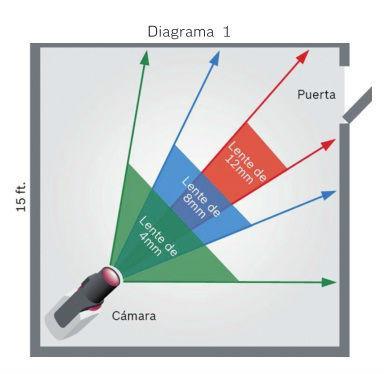
In applications where a closer display is necessary (for example, over a cash register or at a great distance), an 8 mm or 12 mm lens is a better option. The same camera at a distance of 21 feet with a 12mm lens, the FOV will be about 6' vertical and 9' horizontal.
Increasing the focal length of the lens decreases the perceived distance to the viewed area, but also decreases the area that the camera is able to observe. Look at the FOV diagram below for rough visualizations with different focal length lenses.
The FOV can be calculated as follows:
Example: You want the full picture of a tall person (1.8 m.) to appear on the CCTV monitor. The person is approximately 6m. away from the security camera. The camera uses a 1/3" format CCD sensor.
The iris
The iris controls the amount of light that blocks the face of the image sensor. To provide optimal performance, it is critical that there is neither too much nor too little light on the camera sensor. If too much light hits the image sensor, the image "fades" (the image is all white or portions of the image are "very hot", where surfaces with light colors lose detail).
Closing the iris corrects this. At the other extreme, too little light hitting the sensor image generates a black image or only the brightest objects become visible. Opening the iris corrects this situation. Irises can be fixed, operate manually or operate automatically.
Fixed iris: A fixed iris lens does not offer adjustments for different lighting conditions, so it is limited and not convenient for applications where very specific details are required on a constant basis. A manual iris can be adjusted at the time of installation, allowing an optimal image to be obtained for a fixed level of illumination.
Manual Iris: Manual iris lenses are more convenient for indoor applications, where the lighting level is controllable and consistent. For outdoor use (where conditions are usually more variable), an automatic iris offers the best performance, since the automatic aperture of the iris is adjusted to create the optimal image by monitoring the output signal of the camera.
The final feature of the lens to consider is the capture of light according to the speed of the lens, which is expressed as an f-stop number. This literally measures the amount of light captured by the lens in a given period of time. The lower the f-stop range, the more light can be transmitted.
Electronic Iris: In cameras with automatic iris control, the circuit continuously displays the number of shocks that the light gives to the image sensor, opening or closing the iris as appropriate. The Auto iris is especially valuable in configurations where light levels are constantly changing, for example, outdoor locations.
Aperture (f-stop): The aperture is the aperture size of the iris – the opening openings are expressed in f-stops. A lower f-stop translates into a larger aperture, resulting in more light passing through the lens to the sensor image.
This is also known as a faster lens. Instead, a longer f-stop means a smaller aperture, with less light transmitted through the lens.
Iris opening in various F-stops
Image processing
There are some factors that confirm a complete camera specification, and they are interrelated. The three most important when selecting a camera are the following:
• Sensitivity
• Lighting
• Resolution
The correct selection of cameras for your CCTV system is vital to maximize the effectiveness of it. On the other hand, with the camera set available today, you could select "overrated" cameras – those with more capabilities than those required by the app. Choosing cameras with features that match the needs of a given job helps you save significantly on costs and expand or improve your system.
Therefore, when selecting a camera, it is important to know the reason, the place and under what conditions the camera will be used. You can then combine the specifications and capabilities of the camera with your applications.
Camera sensitivity
Sensitivity describes the camera's ability to "take photos" at various levels of lighting. At higher sensitivity, the camera requires less illumination to produce usable images. The terms "usable video" and "full video" are often used in sensitivity talks.
An image that contains some recognizable details, but at the same time has black areas in which the details cannot be clearly observed can be considered usable.
Using a camera with high sensitivity (or adding more light to the same scene) will appear details in areas where only darkness existed. When all the objects in an image are visible, it is described as "full video." Full video is 0.714 volts peak to peak plus 100 IRE (1 IRE = .714 mv). Usable video is usually between 15 and 50 IRE.
The camera's sensitivity measures the amount of light required to provide a standard video signal. Video sensitivity values are typically indicated in lux. Most specifications provide the light levels of eligible and complete videos. Therefore, when considering the sensitivity of a camera, it is important to know the light conditions under which the camera will be used.
Also, you should determine how high the sensitivity should be to produce a usable video with the minimum amount of light available at the surveillance site. There are cameras available that can generate images in low or no light situations. For example, day/night (IR-sensitive) cameras can produce images with only the illumination of stars.
Lighting
Choosing the right camera to operate in ambient light conditions may be the most important, though the most misleading, specification to understand.
Lighting refers to the light that falls on a scene. Strictly speaking, lighting is not a function of the camera. However, it is a critical issue when considering a camera for a given area. Proper lighting is essential to acquire images that allow security personnel to monitor an area (detection), observe activity at the location (reconnaissance), and identify specific actions, objects, or people (identification).
The amount of illumination a scene reaches depends on the time of day and atmospheric conditions. Direct sunlight produces high-contrast scenes, allowing maximum identification of objects. On a cloudy day, the camera receives less light generating lower contrast.
To produce an optimal camera image under wide variation at a high level (such as when the sun is covered by clouds), you need a camera system with automatic iris. Typically, scene lighting is measured in foot-candles (fc) that can range from 10,000 to 1 (or more).
The chart below summarizes the high levels that occur under daylight conditions and low-light hours. The equivalent metric measure of the high level (lux) compared to the condition (fc) is given.
The golden rule for deciding which camera to use for a given lighting condition is not to choose one that delivers an image barely fit for use. Try to give the camera about ten times the minimum illumination of the scene. Most cameras will be able to handle excess light. However, the biggest problem arises when they do not have enough light to produce an image.
*The second part of this article can be found in our next edition (September/October).




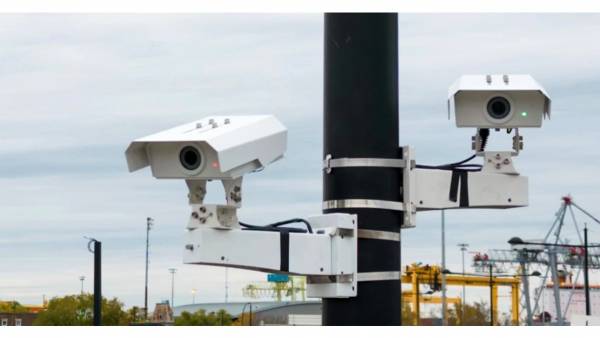
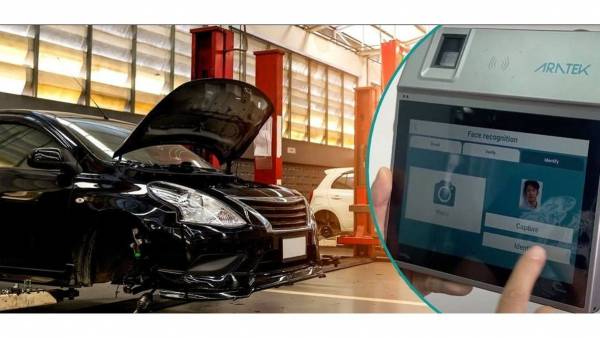
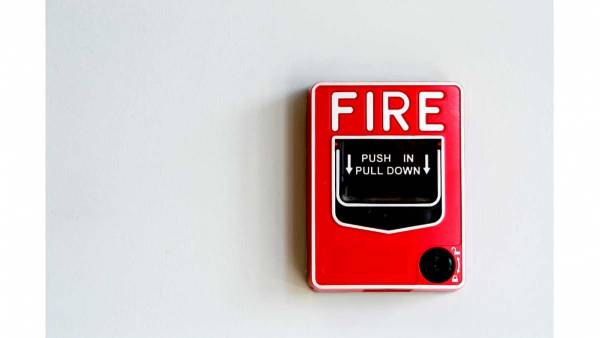

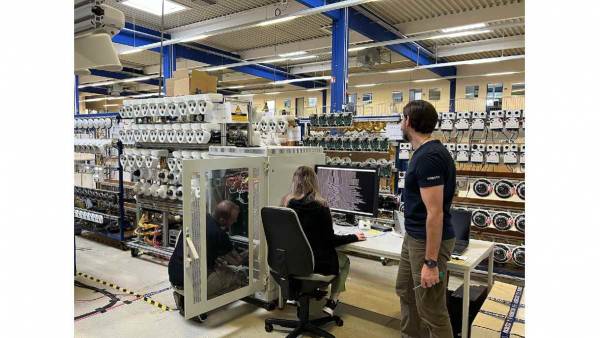















Leave your comment